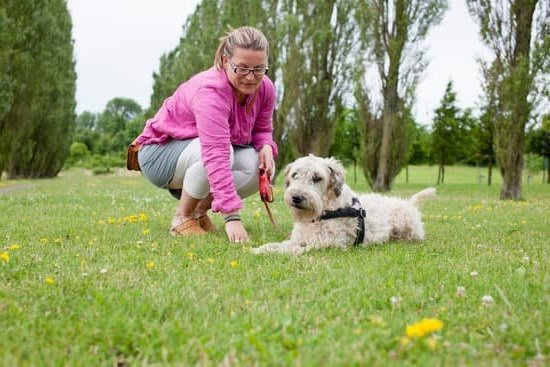When can dogs be trained is a common question among pet owners. Training your dog is not just about teaching them tricks and commands, it’s about building a strong bond and creating a well-behaved and happy companion.
In this article, we will explore the various stages of dog training, from early puppy training to specialized skills and behavioral issues. Understanding the importance of dog training is essential for both the owner and the pet to ensure a fulfilling and harmonious relationship.
Early puppy training is crucial during the critical period for socialization and learning basic commands. We’ll delve into the specific challenges and tips for older dogs in adolescence and beyond, as well as when to start basic obedience training and what commands to focus on. Additionally, we’ll cover advanced training such as agility, sports, and specialized skills, along with addressing common behavioral issues like aggression and anxiety.
Whether your goal is to train your dog for service or therapy work, understanding the requirements and process will be discussed in this article. Furthermore, we will explore breed-specific needs and challenges when it comes to training. By understanding these different aspects of dog training, pet owners can provide their canine companions with lifelong benefits.
Early Puppy Training
Puppies are like sponges, absorbing new information and experiences at a rapid pace. This makes early puppy training a critical period for socialization and basic command learning. But when can dogs be trained? The answer is as soon as they come into your home. It is important to start training your puppy as early as 7-8 weeks old, as this is when they begin to learn social behaviors from their mother and littermates.
During this early training stage, it is crucial to focus on socialization with other dogs, people, and different environments. Exposing your puppy to a variety of sights, sounds, and experiences during this time will help them grow into a well-adjusted and confident adult dog. Basic commands such as sit, stay, come, and walking on a leash should also be introduced during this stage.
Consistency is key when it comes to early puppy training. Short but frequent training sessions throughout the day will help reinforce positive behaviors and build a strong foundation for future learning. Positive reinforcement techniques such as treats, praise, and play should be used to encourage good behavior and create a positive association with training. Starting early with positive training methods will set the stage for a lifetime of successful learning for your canine companion.
Adolescence and Beyond
As dogs enter adolescence and reach maturity, their behavior may change, and they may become more stubborn or independent. However, this does not mean that training should stop. In fact, continuing to train older dogs can help reinforce good behavior and address any new challenges that may arise. Here are some tips for training older dogs:
- Be patient: Older dogs may take longer to learn new commands or behaviors, so it’s important to be patient and consistent with your training.
- Use positive reinforcement: Positive reinforcement, such as treats or praise, can be especially effective with older dogs. This can help motivate them to learn new behaviors and make training a more positive experience.
- Keep training sessions short: Older dogs may have shorter attention spans, so keeping training sessions short and focused can help keep them engaged and prevent frustration.
- Seek professional help if needed: If you’re struggling with training your older dog, don’t hesitate to seek the help of a professional trainer. They can provide guidance and support to help you address any specific challenges you may be facing.
It’s never too late to start or continue training an older dog. While it may require some extra patience and understanding, the benefits of ongoing training for older dogs are well worth the effort. By continuing to train your older dog, you can strengthen your bond, improve their behavior, and ensure they remain well-behaved members of your family.
Basic Obedience Training
When can dogs be trained? Basic obedience training for dogs should ideally start when they are still puppies. The critical period for socialization and learning basic commands is between 3 to 14 weeks of age. During this time, puppies are most receptive to new experiences and have a strong capacity for learning. Starting training during this period can help prevent behavioral issues and lay the foundation for a well-behaved and well-adjusted adult dog.
The key commands to focus on during basic obedience training include sit, stay, come, heel, and leave it. Teaching these commands early on can establish good behavior patterns and make it easier to communicate with your dog as they grow older. Consistency, positive reinforcement, and patience are essential when training young puppies. It’s important to keep training sessions short and fun, using treats or toys as rewards to motivate your puppy.
It’s never too late to start training a dog, but older dogs may require more time and patience. Adolescents and adult dogs can still learn basic obedience commands with the right approach. However, it’s important to be mindful of any behavioral challenges or past experiences that may affect their ability to learn. In some cases, professional trainers or behaviorists may be needed to address specific issues and guide owners in the training process.
| Time Period | Training Objectives |
|---|---|
| 3-14 weeks of age | Socialization and basic commands (sit, stay, come) |
| Adolescence and beyond | Focusing on consistent reinforcement of basic obedience commands |
Advanced Training
When it comes to advanced training for dogs, there are a variety of options that can help them develop specialized skills and enhance their physical and mental abilities. One popular form of advanced training is agility training, which involves teaching dogs to navigate through obstacle courses, jump over hurdles, weave through poles, and more. This type of training not only provides physical exercise but also improves the dog’s coordination, balance, and obedience.
In addition to agility training, many dog owners also explore sports such as flyball, disc dog, dock diving, and even canine musical freestyle. These activities not only provide an outlet for energy but also strengthen the bond between the dog and their owner. Furthermore, they can be a great way to socialize with other dogs and owners who share similar interests.
For those looking to develop specialized skills in their dogs, there are various options available such as search and rescue training, scent work training, and even therapy dog training. These types of advanced training can provide invaluable assistance in real-world scenarios while also allowing dogs to fulfill their natural instincts and desires.
Whether it’s locating a missing person or providing comfort to individuals in need, these specialized skills can make a significant impact on the lives of both dogs and humans.
| Advanced Training Options | Description |
|---|---|
| Agility Training | Teaches dogs to navigate obstacle courses and improves coordination. |
| Sports Activities | Includes flyball, disc dog, dock diving, and musical freestyle. |
| Specialized Skills Training | Involves search & rescue training, scent work training, therapy dog training |
Behavioral Training
Understanding Canine Behavior
Before addressing specific behavioral issues in dogs, it is important to have a good understanding of canine behavior. Dogs may exhibit aggression, anxiety, fear, and other common issues for various reasons. These can include genetics, past experiences, lack of proper socialization, or even medical conditions. Understanding the root cause of the behavior is crucial in developing an effective training plan.
Addressing Aggression
Aggression in dogs can be a serious issue that requires professional intervention. However, training can play a significant role in managing and improving aggressive behavior in dogs. Techniques such as desensitization, counterconditioning, and positive reinforcement can help modify aggressive responses. It is important to seek guidance from a certified dog trainer or behaviorist when dealing with aggression in dogs.
Managing Anxiety and Fear
Anxiety and fear are common issues that many dogs may experience at some point in their lives. Whether it’s separation anxiety, noise phobias, or general fearfulness, behavioral training can help these dogs cope better with their emotions. Training techniques such as desensitization, creating a safe space, and providing mental stimulation through enrichment activities can help mitigate anxiety and fear in dogs.
When can dogs be trained for behavioral issues? The answer is – as early as possible. It’s never too early to start implementing training techniques to address aggression, anxiety, and other common behavioral issues in dogs. Early intervention combined with patience and consistency can greatly improve the overall well-being and behavior of our furry friends.
Training for Service and Therapy Dogs
Service dogs play a crucial role in providing assistance to people with disabilities, whether physical, mental, or emotional. These dogs undergo specific training to perform tasks that aid their owners in their daily activities. On the other hand, therapy dogs provide comfort, affection, and support to individuals in hospitals, nursing homes, schools, and other settings. Training service and therapy dogs involves a unique set of requirements and processes.
Requirements for Service and Therapy Dogs
– Good health: Service and therapy dogs must be in good physical condition to perform their tasks effectively.
– Temperament: These dogs must have a calm, friendly, and obedient temperament to ensure they can handle the demands of their roles.
– Socialization: Service and therapy dogs need to be well-socialized to interact positively with different people and environments.
– Training certification: Both service and therapy dogs may need to obtain specific certifications or credentials to demonstrate their capabilities and qualifications.
Training Process for Service and Therapy Dogs
1. Task-specific training: Service dogs undergo task-specific training based on the needs of their handlers. They learn how to assist with mobility, retrieve items, alert to medical issues, or provide physical support.
2. Public access training: Both service and therapy dogs require training to behave appropriately in public spaces. This includes following commands, remaining calm around distractions, and not engaging with other people or animals without permission.
3. Behavior management: Training also focuses on managing challenging behaviors that could interfere with the dog’s ability to perform their duties effectively.
Additional Considerations
against discrimination for individuals with disabilities who use service animals.
and support to those in need.
When can dogs be trained for these specialized roles? It is generally recommended that training for service and therapy dogs begins early in life during the critical socialization period but continues throughout the dog’s life as they refine their skills. The commitment to ongoing education and training is essential for maintaining the effectiveness of these valuable canine companions.
Training for Specific Breeds
Understanding Breed Characteristics
Each breed has its own set of instincts, energy levels, and tendencies that greatly influence their behavior and response to training. For example, herding breeds like Border Collies may have a strong instinct for chasing and controlling movement, while terriers may display independent and stubborn behaviors. By understanding these characteristics, trainers can tailor their approach to effectively communicate with each breed.
Adapting Training Methods
It’s crucial to adapt training methods based on the unique needs of each breed. For instance, some breeds may respond better to positive reinforcement techniques such as treats and praise, while others may require more structured and consistent training methods. Understanding the breed-specific traits can help trainers modify their techniques to achieve optimal results.
Addressing Breed-Specific Challenges
Certain breeds may present specific challenges such as excessive barking, digging, or high prey drive. When can dogs be trained? Recognizing these challenges early on can help in proactively addressing them through targeted training strategies. Additionally, incorporating mental stimulation and physical exercise that aligns with the breed’s nature can help prevent behavioral issues associated with pent-up energy or boredom.
By understanding the unique needs and challenges of specific breeds, trainers can tailor their approach to effectively address behavioral issues and cultivate desired behaviors in dogs. With the right knowledge and techniques, training for specific breeds can lead to a harmonious relationship between owners and their beloved pets.
Conclusion
In conclusion, the benefits of training and continuing education for dogs cannot be overstated. Starting with early puppy training during the critical period for socialization and basic commands is crucial to setting a solid foundation for your pet’s behavior. However, training should not stop there. Adolescence and beyond bring their own set of challenges, but with patience and consistency, older dogs can continue to learn new skills and behaviors.
Basic obedience training should be started as soon as possible, focusing on commands like sit, stay, come, and leash walking. As your dog progresses, advanced training in agility, sports, or specialized skills can provide mental stimulation and physical activity. Additionally, addressing behavioral issues such as aggression or anxiety through proper training techniques can greatly improve both the quality of life for your pet and your relationship with them.
Whether it’s for service or therapy work or just to understand the unique needs and challenges of specific breeds, ongoing education is key for every dog owner. Training and continued learning throughout their lives will not only benefit the dog but also strengthen the bond between them and their human companions. So remember: when can dogs be trained? The answer is simple – at any age, they are always capable of learning and growing.
Frequently Asked Questions
What Age Is Too Late to Train a Dog?
There isn’t a specific age that is “too late” to train a dog, as they can continue to learn throughout their lives. However, starting early can make training easier and more effective.
What Age Should You Start Dog Training?
It’s best to start training a dog as early as possible, ideally when they are still puppies. This allows them to develop good habits and behaviors from the beginning, making future training easier.
What Is the First Thing You Should Train Your Puppy?
The first thing you should train your puppy is basic obedience commands like “sit,” “stay,” and “come.” These are essential for establishing communication with your dog and building a foundation for more advanced training later on.

Welcome to the blog! I am a professional dog trainer and have been working with dogs for many years. In this blog, I will be discussing various topics related to dog training, including tips, tricks, and advice. I hope you find this information helpful and informative. Thanks for reading!





